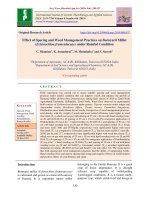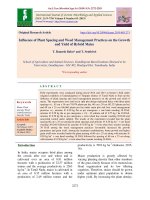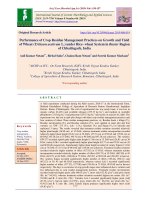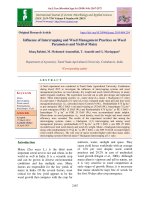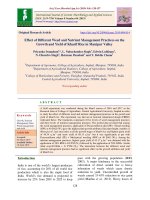Effect of integrated nutrient management practices on nutrient uptake, yield of finger millet (Eleusine coracana L. Gaertn.) and post-harvest nutrient availability under rainfed condition
Bạn đang xem bản rút gọn của tài liệu. Xem và tải ngay bản đầy đủ của tài liệu tại đây (255.21 KB, 9 trang )
Int.J.Curr.Microbiol.App.Sci (2018) 7(8): 339-347
International Journal of Current Microbiology and Applied Sciences
ISSN: 2319-7706 Volume 7 Number 08 (2018)
Journal homepage:
Original Research Article
/>
Effect of Integrated Nutrient Management Practices on Nutrient Uptake,
Yield of Finger Millet (Eleusine coracana L. Gaertn.) and Post-Harvest
Nutrient Availability under Rainfed Condition of Jharkhand
A.K. Roy1*, N. Ali1, R.K. Lakra1, P. Alam1, P. Mahapatra2 and R. Narayan2
1
2
Department of Agronomy, Birsa Agricultural University, Ranchi, Jharkhand, India
Department of Soil Science and Agricultural Chemistry, Birsa Agricultural University,
Ranchi, Jharkhand, India
*Corresponding author
ABSTRACT
Keywords
Finger millet, INM,
FYM, Biofertilizers,
Yield, Nutrient
uptake
Article Info
Accepted:
04 July 2018
Available Online:
10 August 2018
A field experiment entitled “Performance of finger millet (Eleusine coracana L. Gaertn.)
under integrated nutrient management practices” was conducted at Agronomical research
farm of Birsa Agricultural University, Ranchi during Kharif 2016 to study the effect of
integrated nutrient management practices on nutrient uptake, yield of finger millet and
post-harvest availability of nutrients in soil. The experiment was laid out in Randomized
Block Design with 10 treatments replicated thrice. The soil of experimental site was low in
available nitrogen (232.47 Kg/ha), medium in phosphorus (14.30 Kg/ha) and potassium
(131.84 Kg/ha). Result reveled that total uptake of NPK by the crop was higher with
application FYM (10t/ha) + Biofertilizers (Azospirillum brasilense + Bacillus spp. +
Psuedomonas flurosence @ 20 g/kg seed each) + ZnSO4 (12.5 kg/ha) + Borax (5kg/ha) +
100% RDF and was followed by application of FYM (10 t/ha) + Biofertilizers
(Azospirillum brasilense+ Bacillus spp. + Psuedomonas flurosence @ 20 g/kg seed each)
+ ZnSO4 (12.5 kg/ha) + Borax (5kg/ha) + 75% RDF. Available nitrogen, phosphorus were
found highest with application of FYM (10 t/ha) + Biofertilizer + ZnSO4 (12.5 kg/ha) +
Borax (5kg/ha) + 100 % RDF whereas available potassium was found non-significant.
Introduction
Millet is a group of small-grained cereal
grown around the world for food and fodder.
Millets is known to be “crops of the future” as
it is well adapted and cultivated under harsh
environment of arid and semi-arid region
(Resmisa, 2012). Among various millets,
finger millet is one of the important millet
crops of the country as it provides staple food
in relatively short period and dry tracts of the
country. Its name is derived from the seed
head, which has the shape of human fingers.
Locally, the crop is called ragi or marua in
India (National Research Council, 1996).
In India it is cultivated over an area of 1.61
million hectares with total production of about
2.1 million tonnes and productivity 1661 kg
per hectare (AICSMIP, 2013-14). In
Jharkhand, it is cultivated over an area of
0.490 mha with total production of about
339
Int.J.Curr.Microbiol.App.Sci (2018) 7(8): 339-347
27412 ton and productivity 684 kg per hectare
(SAMETI GOJh, 2012-13).
In the present system of intensive agriculture,
mostly farmers are using exhaustive high
yielding varieties of the crops, leading to
heavy withdrawal of nutrients from the soil
during past few years. So crop yield and its
quality can be improved by adequate soil
nutrient and crop management practices
(Pathak et al., 2012). Majorly poor
management of fertilizer has key role to play
in obtaining low yield productivity, in order to
achieve
optimum
crop
productivity
management of nutrients through judicious
application of organic sources, bio-fertilizers
and micro-nutrients is required (Ghaffari et
al., 2011). Beside nutrients availability, FYM
also improves soil physical characteristics
such as structure, porosity and water-holding
capacity through increased organic matter
content of soil. FYM when applied in
conjunction with biofertilizers, supplies
energy to beneficial microorganisms (Jat et
al., 2013). Application of biofertilizer not only
fixes the biological nitrogen but also
solubilizes the insoluble phosphates in soil and
thus improves nutrient availability. Since
fertile soil is the fundamental resource for
higher production, its maintenance is a
prerequisite for long term sustainable crop
production which cannot be maintained by
using chemical fertilizers alone and similarly,
it is not possible to obtain higher crop yield by
using only organic manure (Bair, 2000).
Hence, integrated use of manure and fertilizers
would be quite promising not only in
providing greater stability in production, but
also in maintaining higher soil fertility status
(Nambiar, 2000). Keeping these points in view
a field study on integrated nutrient
management practices was conducted under
poor soil conditions and uneven rainfall
distribution pattern of Jharkhand to study the
effect of INM on nutrient uptake and yield of
finger millet and post-harvest available NPK.
Materials and Methods
A field experiment was conducted on sandy
loam soil of Birsa Agricultural University
Farm, Kanke, Ranchi (23017′ North latitude,
85019′ East longitudes and at an altitude of
625 meter above mean sea level) during
Kharif 2016. The soil of the experimental site
was sandy loam (sand 55.4%, silt 28.3% and
clay 16.3%), having bulk density 1.37 Mg/m3,
organic carbon 4.23 g/kg, acidic in reaction
(pH 5.4), low in available nitrogen (232.47
kg/ha), medium in available phosphorus
(14.30 kg/ha) and potassium (131.84 kg/ha).
The Ragi cultivar A-404 was of medium
duration with seed rate 10 kg/ha and spacing
of 30 cm ×10 cm. The experiment was laid out
in a Randomized Block Design (RBD) and
replicated thrice with ten treatments. The
treatments consisted of: T1. Absolute control,
T2. FYM (10 t/ha), T3. Recommended dose of
fertilizers (NPK @ 50:30:25 kg/ha,
respectively),
T4.
FYM
(10t/ha)
+
Biofertilizers (Azospirillum brasilense +
Bacillus spp. + Psuedomonas flurosence @ 20
g/kg seed each), T5. T4 + ZnSO4 (12.5 kg/ha),
T6. T4 + Borax (5 kg /ha), T7. T4 + ZnSO4
(12.5 kg/ha) + Borax (5 kg/ha), T8. T4 +
ZnSO4 (12.5 kg/ha) + Borax (5kg/ha) + 50%
RDF, T9. T4 + ZnSO4 (12.5 kg/ha) + Borax
(5kg/ha) + 75% RDF, T10. T4 + ZnSO4 (12.5
kg/ha) + Borax (5kg/ha) + 100% RDF.
Organic source of nutrients used in the
experiment was farm yard manure (FYM).
Inorganic sources were N, P and K containing
fertilizers such as Urea, Single super
phosphate, Murate of potash. Zinc and Boron
was applied in the form of Zinc sulphate and
Borax respectively. The biofertilizers used for
seed inoculation were Azospirillum brasilense,
Bacillus spp. and Psuedomonas flurosence. In
case of organic nutrient management, the
requisite quantity of FYM was applied as per
the treatments and incorporated well in
advance i.e. two weeks before sowing of the
340
Int.J.Curr.Microbiol.App.Sci (2018) 7(8): 339-347
crop. One third of urea, full dose of SSP,
Murate of Potash along with Zinc sulphate and
Borax were applied at the time of sowing as
basal dose and remaining urea was applied in
two split doses viz., 1/3 at tillering stage (30
DAS) and 1/3 before ear head initiation (55
DAS) as per various treatments. The grain and
straw yield of finger millet were recorded
treatment wise from net plot area at harvest
and converted into quintal per hectare basis.
For plant nutrient uptake plant samples
collected for recording dry matter estimation
at harvest were oven dried, grinded and
digested for chemical analysis. The nutrient
uptake (kg/ha) was calculated by using their
nitrogen,
phosphorus
and
potassium
concentration (%) values and yield of crop
plant on hectare basis. Nutrient uptake was
calculated as:
Nutrient concentration (%) ×
Grain/Straw yield (kg/ha)
Nutrient uptake (kg/ha) = ------------------------100
Pre-sowing and post-harvest soil of
experimental plot were subjected to analysis
for which soil samples (0-15 cm depth) were
collected from five different places from each
treatment plots and mixed thoroughly for
preparing composite soil sample. The
composite samples were air dried, grinded,
sieved and used for the estimation of residual
nutrient status of soil by adopting standard
methods. The collected data for various
parameters were statistically analysed using
the method of analysis of variance (ANOVA)
as described by Gomez and Gomez (1984).
The significance of comparison was tested.
The significant difference values were
computed for 5 percent probability of error.
Wherever the variance ratio (F value) was
found significant, critical difference (CD)
values were computed for the comparison
among the treatment means (Table 1).
Results and Discussion
Yield
Grain and straw yield of finger millet (Table 2
and Fig. 1) significantly differed with varying
level of inorganic fertilizers in association
with FYM and biofertilizers over control.
Maximum grain yield (3773 kg/ha) was
recorded with the combined application of
organic, inorganic and biofertilizers i.e.,
application of FYM (10 t/ha) + Biofertilizer +
ZnSO4 (12.5 kg/ha) + Borax (5kg/ha) + 75%
RDF followed by application of FYM (10
t/ha) + Biofertilizers + ZnSO4 (12.5 kg/ha) +
Borax (5kg/ha) + 100 % RDF (3542 kg/ha)
but significantly superior to rest of the
treatments. Higher grain yield with combined
application of FYM, biofertilizer and
increasing level of inorganics may be due to
increased availability of nutrients and
improved the soil properties.
This in turn, increased absorption and
translocation of nutrient by crop leading to
increased production of photosynthates by the
crop. Organic manure provided favourable
environment
for
microorganism
i.e.
Azospirillum which fixes atmospheric nitrogen
available to plants. Further, PSB is one of the
most
important
nutrient
solubilizing
microorganisms, which convert insoluble
phosphate into soluble forms by secreting
several organic acids. These results are in line
with the findings of Khan et al., (2012) and Jat
et al., (2013).
Maximum straw yield (7695 kg/ha) was
recorded with application of FYM (10 t/ha) +
Biofertilizers + ZnSO4 (12.5 kg/ha) + Borax
(5kg/ha) + 100 % RDF followed by
application of FYM (10 t/ha) + Biofertilizers +
ZnSO4 (12.5 kg/ha) + Borax (5kg/ha) + 75%
RDF (6983 kg/ha). Higher straw yield was
recorded under combined use of biofertilizers,
organics and 100% RDF due to higher
341
Int.J.Curr.Microbiol.App.Sci (2018) 7(8): 339-347
vegetative growth as a result of greater
nitrogen dose in T10 than rest of treatments.
The increased availability of the nutrients
especially nitrogen due to combined
application of FYM, inorganic fertilizers and
biofertilizers, lead to enhancement of the
photosynthetic rate resulting in more
vegetative growth and dry matter production.
These results are in conformity with the
results of Pratap et al., (2008).
Fig.1 Grain yield (kg/ha) and Straw yield (kg/ha) of finger millet as affected by Integrated
Nutrient Management practices
Fig.2 NPK uptake (kg/ha) by finger millet as affected by Integrated Nutrient
Management practices
342
Int.J.Curr.Microbiol.App.Sci (2018) 7(8): 339-347
Table.1 Nitrogen, phosphorus and potassium content in finger millet grain and straw as affected by
integrated nutrient management practices
Treatments
Nitrogen %
Phosphorus %
Potassium %
Grain
Straw
Grain
Straw
Grain
Straw
T1: Absolute control
1.22
0.37
0.319
0.069
0.411
1.04
T2: FYM (10 t/ha)
1.25
0.41
0.327
0.072
0.423
1.06
T3: Recommended dose of fertilizers (NPK @50:30:25
kg/ha, respectively)
1.34
0.46
0.353
0.083
0.497
1.11
T4: FYM (10 t/ha)+ Biofertilizers (Azospirillum
brasilense + Bacillus spp. + Psuedomonas flurosence
@20 g/kg seed each)
1.28
0.42
0.331
0.074
0.427
1.07
T5: T4 + ZnSO4 (12.5 kg/ha)
1.29
0.43
0.331
0.074
0.427
1.07
T6: T4 + Borax (5 kg/ha)
1.30
0.43
0.332
0.075
0.428
1.08
T7: T4 + ZnSO4 (12.5 kg/ha) + Borax (5 kg/ha)
1.31
0.44
0.332
0.075
0.429
1.09
T8: T4 +ZnSO4 (12.5 kg/ha) + Borax (5 kg/ha) + 50%
RDF
1.39
0.51
0.362
0.089
0.501
1.13
T9: T4 + ZnSO4 (12.5 kg/ha)+Borax (5 kg/ha) + 75%
RDF
1.45
0.55
0.367
0.092
0.507
1.15
T10: T4 + ZnSO4 (12.5 kg/ha)+Borax (5 kg/ha) + 100%
RDF
1.43
0.58
0.365
0.094
0.504
1.16
SE m ±
0.05
0.02
0.010
0.003
0.018
0.04
CD (P = 0.05)
0.14
0.05
0.031
0.008
0.053
0.12
CV%
6.11
6.85
5.273
5.876
6.768
6.38
343
Int.J.Curr.Microbiol.App.Sci (2018) 7(8): 339-347
Table.2 NPK uptake (kg/ha) and yield (kg/ha) of finger millet as affected by Integrated Nutrient Management practices
Treatments
Nutrient uptake (kg/ha)
Nitrogen
Yield (kg/ha)
Phosphorous
Potassium
Grain
Straw
Total
Grain
Straw
Total
Grain
Straw
Total
Grain
Straw
T1 :
14.60
10.24
24.84
3.82
1.91
5.73
4.92
28.81
33.73
1197
2770
T2 :
21.72
16.18
37.90
5.68
2.84
8.52
7.35
41.84
49.11
1738
3947
T3 :
32.03
24.44
56.47
8.44
4.05
12.49
11.89
54.16
66.05
2391
4879
T4 :
25.81
19.10
44.91
6.68
3.37
10.05
6.61
48.67
56.83
2017
4549
T5 :
26.29
19.78
46.07
6.75
3.40
10.15
8.70
49.23
57.93
2038
4601
T6 :
27.20
19.93
47.13
6.95
3.47
10.43
8.96
50.07
59.02
2093
4637
T7 :
27.60
20.42
48.02
6.99
3.48
10.47
9.03
50.61
59.64
2107
4643
T8 :
45.28
31.19
78.47
11.79
5.44
17.23
16.32
69.11
85.43
3258
6116
T9 :
54.70
38.40
93.10
13.85
6.51
20.36
19.13
80.31
99.43
3773
6983
T10:
50.65
41.63
92.28
12.93
6.98
19.91
17.85
89.26
107.14
3542
7695
SE m ±
1.41
1.18
2.24
0.32
0.17
0.47
0.46
3.08
2.78
143
313
CD (P = 0.05)
4.18
3.51
6.64
0.94
0.51
1.39
1.36
9.15
8.26
432.16
929.74
CV%
7.48
8.49
6.81
6.52
7.14
6.45
7.15
9.50
7.15
10.43
10.66
344
Int.J.Curr.Microbiol.App.Sci (2018) 7(8): 339-347
Table.3 Available NPK (kg/ha) in soil after harvest as affected by Integrated Nutrient
Management practices
Treatment
Available Available Available
N
P
K
187.64
7.07
95.48
T1: Absolute control
199.57
11.78
102.65
T2: FYM (10 t/ha)
204.74
14.81
99.79
T3: Recommended dose of fertilizers (NPK @50:30:25 kg/ha,
respectively)
206.64
14.25
106.01
T4: FYM (10 t/ha) + Biofertilizers (Azospirillum brasilense +
Bacillus spp. + Psuedomonas flurosence @20 g/kg seed each)
206.44
14.15
104.91
T5: T4 + ZnSO4 (12.5 kg/ha)
205.34
13.87
103.82
T6: T4 + Borax (5 kg/ha) @ 5 kg/ha
204.48
13.83
103.20
T7: T4 + ZnSO4 (12.5 kg/ha) + Borax (5 kg/ha)
228.11
17.07
107.43
T8: T4 + ZnSO4 (12.5 kg/ha) + Borax (5 kg/ha)+50% RDF
230.43
18.94
108.32
T9: T4 + ZnSO4 (12.5 kg/ha) + Borax (5 kg/ha) +75% RDF
233.83
19.68
108.96
T10: T4 + ZnSO4 (12.5 kg/ha) + Borax (5 kg/ha) + 100% RDF
8.18
0.54
4.62
SE m ±
24.29
1.60
NS
CD (P = 0.05)
6.72
6.43
7.70
CV%
232.47
14.30
131.84
Initial Soil Status
the corresponding treatment could be due to
the higher grain yield and sustained
availability of nutrients through organic and
inorganic fertilizers along with Bacillus spp.
Results obtained were in close conformity of
Rathore et al., (2006), Choudhary and
Gautam (2007).
NPK uptake by grain
The nutrient uptake is a function of yield and
nutrient concentration in plant. Uptake of
NPK by grain was higher with application of
FYM (10 t/ha) + Biofertilizer + ZnSO4 (12.5
kg/ha) + Borax (5kg/ha) + 75% RDF which
was at par with application of FYM (10 t/ha)
+ Biofertilizer + ZnSO4 (12.5 kg/ha) + Borax
(5kg/ha) + 100% RDF (Table 2 and Fig. 2).
This is due to higher grain yield in T9
treatment i.e. application of FYM (10 t/ha) +
Biofertilizers + ZnSO4 (12.5 kg/ha) + Borax
(5kg/ha) + 75% RDF. Combined application
of organic, inorganic fertilizers and
biofertilizers created favourable nutritional
environment to the plant rhizosphere which
enhanced the photosynthetic activity and
translocation of nutrients thus increasing the
grain yield and nitrogen uptake by grain.
Moreover, increased availability and uptake
of phosphorus was due to solubilizing effect
of PSB. The enhanced uptake of potassium in
NPK uptake by straw
Uptake of NPK by straw was higher with
application of FYM (10 t/ha) + Biofertilizer +
ZnSO4 (12.5 kg/ha) + Borax (5kg/ha) + 100%
RDF which was at par with application of
FYM (10 t/ha) + Biofertilizer + ZnSO4 (12.5
kg/ha) + Borax (5kg/ha) + 75% RDF (Table 2
and Fig. 2). This is due to higher straw yield
in T10 treatment. Due to higher nitrogen dose
there was excessive vegetative growth and
hence greater straw yield in T10 treatment i.e.,
application of FYM (10 t/ha) + Biofertilizers
+ ZnSO4 (12.5 kg/ha) + Borax (5kg/ha) +
100% RDF. As due to in general, the trend of
345
Int.J.Curr.Microbiol.App.Sci (2018) 7(8): 339-347
nutrient uptake very well resembled with dry
matter accumulation and per hectare straw yield
data of various treatments hence higher nutrient
content in the produce and higher biomass
production of finger millet might be the relevant
reason for higher uptake of NPK. Results
obtained were in close conformity of Kalibhavi
et al., (2003) and Rathore et al., (2006).
application of FYM (10 t/ha) + Biofertilizers +
ZnSO4 (12.5 kg/ha) + Borax (5kg/ha) + 100%
RDF followed by application of FYM (10 t/ha)
+ Biofertilizers + ZnSO4 (12.5 kg/ha) + Borax
(5kg/ha) + 75% RDF (Table 3). This might be
due to the release of organic acids during
microbial decomposition of organic matter
which helped in the solubility of native
phosphates
thus
increasing
available
phosphorus. Further, PSB application resulted
in greater mobilisation of insoluble inorganic
phosphate and mineralization of organic P.
Hence it may be concluded that the increased
availability of nutrients was due to
improvement in soil physical, chemical and
biological health through application of organic
and inorganic fertilizers along with biofertilizer
under integrated nutrient management. Similar
results were observed by and Tolanur and
Badanur (2003) and Dass et al., (2008).
Available potassium status was not significantly
influenced by different combination of nutrient
sources (Table 3).
Total NPK uptake
Total uptake of N and P was higher with
application of FYM (10 t/ha) + Biofertilizer +
ZnSO4 (12.5 kg/ha) + Borax (5kg/ha) + 75%
RDF which was at par with application of FYM
(10 t/ha) + Biofertilizer + ZnSO4 (12.5 kg/ha) +
Borax (5kg/ha) + 100% RDF whereas K uptake
was found higher with application of FYM (10
t/ha) + Biofertilizer + ZnSO4 (12.5 kg/ha) +
Borax (5kg/ha) + 100% RDF (Table 2 and Fig.
2). The significant improvement in content and
removal of nutrients as a consequence of
organic and inorganic fertilizer with biofertilizer
was important in improving nutrient availability
pattern of soil which might have reflected on
grain and straw yield and resulted ultimately in
nutrient content and uptake of nutrient by grain
and straw. Results obtained were in close
conformity of Choudhary & Gautam (2007).
References
AICSMIP, All India Co-ordinated Small Millets
Improvement Project Annual Report.
2002. GKVK Campus, UAS, Bangalore.
Bair, C.A. 2000. Methods of Soil Analysis. Part
I
and
II.
American
Society of Agronomy, Inc.,
Publisher.
Madison, Wisconsin, USA.
Choudhary, R.S and Gautam, R.C. 2007. Effect
of nutrient management practices on
growth and yield of pearl millet
(Pennisetum glaucum L.). Indian Journal
of Agronomy 52(1): 64-66.
Dass, A., Lenka, N.K., Sudhishri, S. and
Patnaik, U.S. 2008. Influence of
integrated nutrient management on
production, economics and soil properties
in tomato (Lycopersicon esculentum)
under on-farm condition in Eastern Ghats
of Orissa. Indian Journal of Agricultural
Sciences 78: 40-43.
Ghaffari, A., Ali, A., Tahir, M., Waseem, M.
and Ayub, M. 2011. Influence of
Integrated Nutrients on Growth, Yield
Post-harvest available NPK (kg/ha)
Higher available nitrogen content was observed
with application of FYM (10 t/ha) +
Biofertilizers + ZnSO4 (12.5 kg/ha) + Borax
(5kg/ha) + 100% RDF followed by application
of FYM (10 t/ha) + Biofertilizers + ZnSO4 (12.5
kg/ha) + Borax (5kg/ha) + 75% RDF >
application of FYM (10 t/ha) + Biofertilizers +
ZnSO4 (12.5 kg/ha) + Borax (5kg/ha) + 50%
RDF (Table 3). The higher available N was
observed with integrated use of FYM, inorganic
fertilizers and biofertilizers. Higher availability
of N may be attributed to the addition of N by
FYM, Azospirillum by biological nitrogen
fixation and increasing level of N fertilizers.
Similar findings were reported by Sarma et al.,
(2007). In case of Phosphorus, higher available
phosphorus in soil was observed with
346
Int.J.Curr.Microbiol.App.Sci (2018) 7(8): 339-347
and Quality of Maize (Zea mays L.).
American Journal of Plant Science 2: 6369.
Gomez, K.A. and Gomez, A.A. 1984. Statistical
procedures for agricultural research. A
Willey-Interscience Publication, John
Willey and Sons, New York.
Jat, M.L., Gathala, M.K., Saharawat, Y.S.,
Tetarwal, J.P., Gupta, R. and Singh, Y.
2013. Double no-till and permanent raised
beds in maize–wheat rotation of northwestern Indo-Gangetic Plains of India:
effects on crop yields, water productivity,
profitability and soil physical properties.
Field Crops Reseach 149: 291-299.
Kalibhavi, C., Kachapur, M.D. and Patil, R.H.
2003. Studies on integrated nutrient
management in rabi sorghum. Journal of
Maharashtra Agricultural Universities
28(1): 104-105.
Khan, M.A.A., Rajamani, K. and Reddy, A.P.K.
2012. Nutrient management in rabi sweet
sorghum grown as inter-crop in Pongamia
based agri-silvi culture system. Journal of
the Indian Society of Soil Science 60(4):
335-339.
Nambiar, K.K.M. 2000. Long-term fertility
effects on wheat productivity. Proc.
Wheat for non-traditional warm areas,
(Saunders. O.A. ed), CIMMYT. 1: 516521.
NRC (National Research Council).1996. Lost
Crops of Africa, 1st ed.; National
Academy Press: Washington DC, USA.
Pathak G.C., Gupta B., Pandey N. 2012.
Improving reproductive efficiency of
chickpea by foliar application of zinc.
Brazilian Journal of Plant Physiology
24(3):173-180.
Pratap, R., Sharma, O.P. and Yadav, G.L. 2008.
Effect of integrated nutrient management
under varying levels of zinc on pearl
millet yield. Annals of Arid Zone 47(2):
197-199.
Rathore, V.S., Singh, P. and Gautam, R.C.
2006. Productivity and water use
efficiency of rainfed pearl millet
(Pennisetum glaucum L.) as influenced by
planting pattern and integrated nutrient
management.
Indian
Journal
of
Agronomy 51(1): 46-48.
Resmisa (Revalorising Small Millets in Rainfed
Regions of South Asia). 2012. Supporting
Millets in India. Policy Review &
Suggestions for Action. pp.6.
SAMETI (State Agricultural Management and
Extension Training Institute) Govt. of
Jharkhand, 2012 -13
Sarma, A., Singh, H. and Nanwal, R.K. 2007.
Effect of integrated nutrient management
on productivity of wheat (Triticum
aestivum) under limited and adequate
irrigation supplies. Indian Journal of
Agronomy 52: 120-123.
Tolanur, S.I. and Badanur, V.P. 2003. Effect of
integrated use of organic manure, green
manure and fertilizer nitrogen on
sustaining productivity of rabi sorghumchickpea system and fertility of a vertisol.
Journal of Indian Society of Soil Science
51: 41-44.
How to cite this article:
Roy, A.K., N. Ali, R.K. Lakra, P. Alam, P. Mahapatra and Narayan, R. 2018. Effect of Integrated
Nutrient Management Practices on Nutrient Uptake, Yield of Finger Millet (Eleusine coracana L.
Gaertn.) and Post-Harvest Nutrient Availability under Rainfed Condition of Jharkhand.
Int.J.Curr.Microbiol.App.Sci. 7(08): 339-347. doi: />
347
